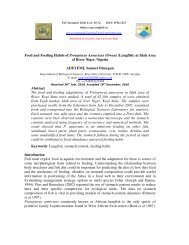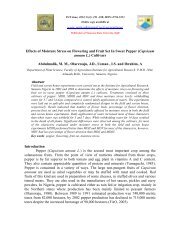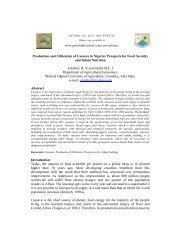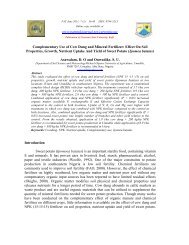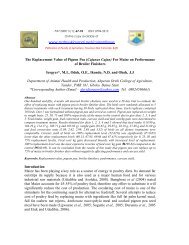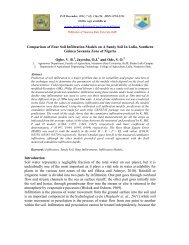Effects of Time and Method of Pig Manure Application on Growth ...
Effects of Time and Method of Pig Manure Application on Growth ...
Effects of Time and Method of Pig Manure Application on Growth ...
You also want an ePaper? Increase the reach of your titles
YUMPU automatically turns print PDFs into web optimized ePapers that Google loves.
PAT 2011;7 (1): 103 -116 ISSN: 0794-5213; Iren et al.,, <str<strong>on</strong>g>Effects</str<strong>on</strong>g> <str<strong>on</strong>g>of</str<strong>on</strong>g> <str<strong>on</strong>g>Time</str<strong>on</strong>g> <str<strong>on</strong>g>and</str<strong>on</strong>g> <str<strong>on</strong>g>Method</str<strong>on</strong>g> <str<strong>on</strong>g>of</str<strong>on</strong>g> <str<strong>on</strong>g>Pig</str<strong>on</strong>g> <str<strong>on</strong>g>Manure</str<strong>on</strong>g> <str<strong>on</strong>g>Applicati<strong>on</strong></str<strong>on</strong>g> .. 108<br />
The time <str<strong>on</strong>g>of</str<strong>on</strong>g> manure applicati<strong>on</strong> significantly influenced the number <str<strong>on</strong>g>of</str<strong>on</strong>g> leaves<br />
per Amaranthus plant at all stages <str<strong>on</strong>g>of</str<strong>on</strong>g> growth (Table 7). However, the average <str<strong>on</strong>g>of</str<strong>on</strong>g> the two<br />
years (Table 8) showed that the AP time <str<strong>on</strong>g>of</str<strong>on</strong>g> manure applicati<strong>on</strong> enhanced greater<br />
number <str<strong>on</strong>g>of</str<strong>on</strong>g> leaves per plant at all stages <str<strong>on</strong>g>of</str<strong>on</strong>g> growth though not significantly greater than<br />
the 1 WBP time <str<strong>on</strong>g>of</str<strong>on</strong>g> manure applicati<strong>on</strong>.<br />
There was a significant time x method <str<strong>on</strong>g>of</str<strong>on</strong>g> applicati<strong>on</strong> <strong>on</strong> the number <str<strong>on</strong>g>of</str<strong>on</strong>g><br />
Amaranthus leaves per plant at 3 WAP with the 1 WBP time using the broadcast with<br />
incorporati<strong>on</strong> method having the highest number <str<strong>on</strong>g>of</str<strong>on</strong>g> leaves per plant (Table 9). There<br />
was significant time x method <str<strong>on</strong>g>of</str<strong>on</strong>g> applicati<strong>on</strong> <strong>on</strong> the number <str<strong>on</strong>g>of</str<strong>on</strong>g> Amaranthus leaves per<br />
plant at 4 WAP (Figure 2) <str<strong>on</strong>g>and</str<strong>on</strong>g> 5 WAP (Figure 3) in both years. However, from the<br />
overall effect <str<strong>on</strong>g>of</str<strong>on</strong>g> time x method interacti<strong>on</strong> at 4 WAP in both years, the highest number<br />
<str<strong>on</strong>g>of</str<strong>on</strong>g> 23.50 was obtained from the AP time using the b<str<strong>on</strong>g>and</str<strong>on</strong>g> placement without<br />
incorporati<strong>on</strong> method <str<strong>on</strong>g>of</str<strong>on</strong>g> applicati<strong>on</strong> (Table 10) while at 5 WAP growth stage, the<br />
highest average number <str<strong>on</strong>g>of</str<strong>on</strong>g> leaves per plant <str<strong>on</strong>g>of</str<strong>on</strong>g> 36.43 (Table 11) was obtained from the 1<br />
WBP time using the broadcast with incorporati<strong>on</strong> method. Generally, the 1 WBP time<br />
<str<strong>on</strong>g>of</str<strong>on</strong>g> manure applicati<strong>on</strong> using the broadcast with incorporati<strong>on</strong> method would be the best<br />
for Amaranthus producti<strong>on</strong> in the Umudike envir<strong>on</strong>ment as this would minimize<br />
nitrogen losses due to volatilizati<strong>on</strong> <str<strong>on</strong>g>and</str<strong>on</strong>g> also enhanced the sustainability <str<strong>on</strong>g>of</str<strong>on</strong>g> the crop.<br />
Effect <str<strong>on</strong>g>of</str<strong>on</strong>g> time <str<strong>on</strong>g>and</str<strong>on</strong>g> method <str<strong>on</strong>g>of</str<strong>on</strong>g> pig manure applicati<strong>on</strong> <strong>on</strong> fresh <str<strong>on</strong>g>and</str<strong>on</strong>g> dry matter<br />
yields <str<strong>on</strong>g>of</str<strong>on</strong>g> Amaranthus<br />
The method <str<strong>on</strong>g>of</str<strong>on</strong>g> pig manure applicati<strong>on</strong> <strong>on</strong> the fresh <str<strong>on</strong>g>and</str<strong>on</strong>g> dry matter yield <str<strong>on</strong>g>of</str<strong>on</strong>g><br />
Amaranthus in both years did not produce significant (P >0.05) differences. The fresh<br />
<str<strong>on</strong>g>and</str<strong>on</strong>g> dry matter yield <str<strong>on</strong>g>of</str<strong>on</strong>g> Amaranthus in both years were significantly (P



